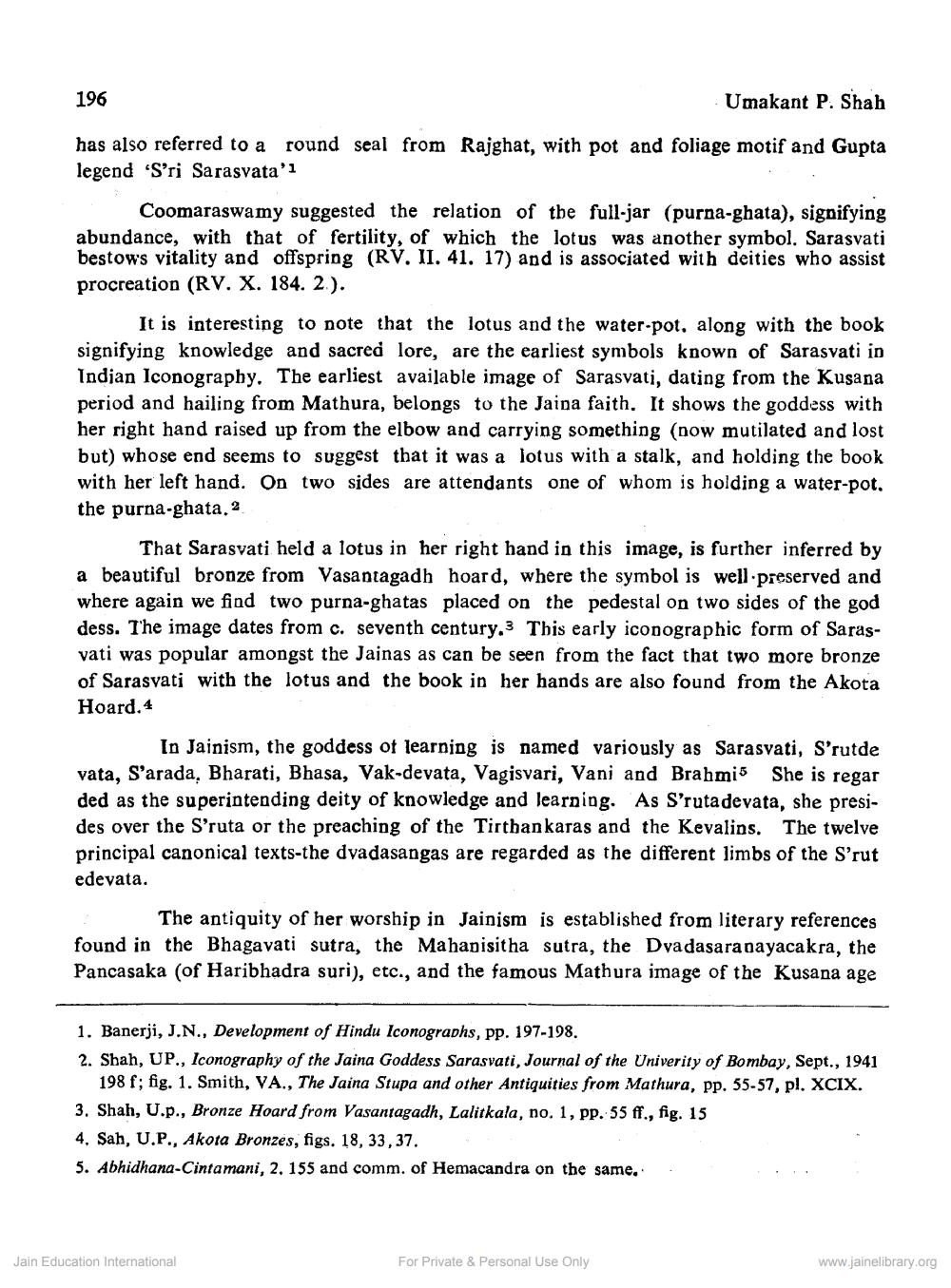________________
196
Umakant P. Shah
has also referred to a round seal from Rajghat, with pot and foliage motif and Gupta legend 'Sri Sarasvata'i
Coomaraswamy suggested the relation of the full-jar (purna-ghata), signifying abundance, with that of fertility, of which the lotus was another symbol. Sarasvati bestows vitality and offspring (RV. II. 41. 17) and is associated with deities who assist procreation (RV. X. 184. 2.).
It is interesting to note that the lotus and the water-pot, along with the book signifying knowledge and sacred lore, are the earliest symbols known of Sarasvati in Indian Iconography. The earliest available image of Sarasvati, dating from the Kusana period and hailing from Mathura, belongs to the Jaina faith. It shows the goddess with her right hand raised up from the elbow and carrying something (now mutilated and lost but) whose end seems to suggest that it was a lotus with a stalk, and holding the book with her left hand. On two sides are attendants one of whom is holding a water-pot. the purna-ghata. 2
That Sarasvati held a lotus in her right hand in this image, is further inferred by a beautiful bronze from Vasantagadh hoard, where the symbol is well preserved and where again we find two purna-ghatas placed on the pedestal on two sides of the god dess. The image dates from c. seventh century.3 This early iconographic form of Sarasvati was popular amongst the Jajnas as can be seen from the fact that two more bronze of Sarasvati with the lotus and the book in her hands are also found from the Akota Hoard. 4
In Jainism, the goddess of learning is named variously as Sarasvati, S'rutde vata, S'arada, Bharati, Bhasa, Vak-devata, Vagisvari, Vani and Brahmi5 She is regar ded as the superintending deity of knowledge and learning. As S'ruta devata, she presides over the Sruta or the preaching of the Tirthankaras and the Kevalins. The twelve principal canonical texts-the dvadasangas are regarded as the different limbs of the S'rut edevata.
The antiquity of her worship in Jainism is established from literary references found in the Bhagavati sutra, the Mahapisitha sutra, the Dvadasaranayacakra, the Pancasaka (of Haribhadra suri), etc., and the famous Mathura image of the Kusana age
1. Banerji, J.N., Development of Hindu Iconographs, pp. 197-198. 2. Shah, UP., Iconography of the Jaina Goddess Sarasvati, Journal of the Univerity of Bombay, Sept., 1941
198 f; fig. 1. Smith, VA., The Jaina Stupa and other Antiquities from Mathura, pp. 55-57, pl. XCIX. 3. Shah, U.P., Bronze Hoard from Vasantagadh, Lalitkala, no. 1, pp. 55 ff., fig. 15 4. Sah, U.P., Akota Bronzes, figs. 18, 33, 37. 5. Abhidhana-Cintamani, 2. 155 and comm. of Hemacandra on the same. .
Jain Education International
For Private & Personal Use Only
www.jainelibrary.org




